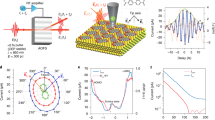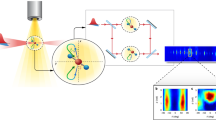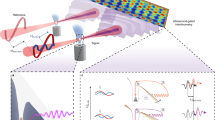Abstract
A strong laser field may tunnel ionize a molecule from several orbitals simultaneously, forming an attosecond electron–hole wavepacket. Both temporal and spatial information on this wavepacket can be obtained through the coherent soft X-ray emission resulting from the laser-driven recollision of the liberated electron with the core. By characterizing the emission from aligned N2 molecules, we demonstrate the attosecond contributions of the two highest occupied molecular orbitals. We determine conditions where they are disentangled in the real and imaginary parts of the emission dipole moment. This allows us to carry out a tomographic reconstruction of both orbitals with angstrom spatial resolution. Their coherent superposition provides experimental images of the attosecond wavepacket created in the ionization process. Our results open the prospect of imaging ultrafast intramolecular dynamics combining attosecond and angstrom resolutions.
This is a preview of subscription content, access via your institution
Access options
Subscribe to this journal
Receive 12 print issues and online access
$209.00 per year
only $17.42 per issue
Buy this article
- Purchase on Springer Link
- Instant access to full article PDF
Prices may be subject to local taxes which are calculated during checkout





Similar content being viewed by others
References
Uiberacker, M. et al. Attosecond real-time observation of electron tunnelling in atoms. Nature 446, 627–632 (2007).
Eckle, P. et al. Attosecond ionization and tunnelling delay time measurements in helium. Science 322, 1525–1529 (2008).
Niikura, H. et al. Probing molecular dynamics with attosecond resolution using correlated wavepacket pairs. Nature 421, 826–829 (2003).
Mauritsson, J. et al. Coherent electron scattering captured by an attosecond quantum stroboscope. Phys. Rev. Lett. 100, 073003 (2008).
Mairesse, Y. et al. Attosecond synchronization of high harmonic soft X-ray. Science 302, 1540–1543 (2003).
Sola, I. et al. Controlling attosecond electron dynamics by phase-stabilized polarization gating. Nature Phys. 2, 319–322 (2006).
Dudovich, N. L. et al. Measuring and controlling the birth of attosecond XUV pulses. Nature Phys. 2, 781–786 (2006).
Cavallieri, A. et al. Attosecond spectroscopy in condensed matter. Nature 449, 1029–1032 (2007).
Drescher, M. et al. Time-resolved atomic inner-shell spectroscopy. Nature 419, 803–807 (2002).
Fohlisch, A. et al. Direct observation of electron dynamics in the attosecond domain. Nature 436, 373–376 (2005).
Haessler, S. et al. Phase-resolved attosecond near-threshold photoionization of molecular nitrogen. Phys. Rev. A 80, 011404 (2009).
Nakamura, H. Nonadiabatic Transitions. Concepts, Basic Theories and Applications (World Scientific Publishing, 2002).
Breidbach, J. & Cederbaum, L. S. Universal attosecond response to the removal of an electron. Phys. Rev. Lett. 94, 033901 (2005).
Hu, S. X. & Collins, L. A. Attosecond pump probe: exploring ultrafast electron motion inside an atom. Phys. Rev. Lett. 96, 073004 (2006).
Remacle, F. & Levine, R. D. An electronic time scale in chemistry. Proc. Natl Acad. Sci. USA 103, 6793–6798 (2006).
Smirnova, O. et al. High harmonic interferometry of multi-electron dynamics in molecules. Nature 460, 972–977 (2009).
Smirnova, O., Patchkovskii, S., Mairesse, Y., Dudovich, N. & Ivanov, M. Y. Strong-field control and spectroscopy of attosecond electron–hole dynamics in molecules. Proc. Natl Acad. Sci. USA 106, 16556–16561 (2009).
Schafer, K. J., Yang, B., DiMauro, L. F. & Kulander, K. C. Above threshold ionization beyond the high harmonic cutoff. Phys. Rev. Lett. 70, 1599–1602 (1993).
Corkum, P. B. Plasma perspective on strong field multiphoton ionization. Phys. Rev. Lett. 71, 1994–1997 (1993).
Krausz, F. & Ivanov, M. Y. Attosecond physics. Rev. Mod. Phys. 81, 163–245 (2009).
Baker, S. et al. Dynamic two-centre interference in high-order harmonic generation from molecules with attosecond nuclear motion. Phys. Rev. Lett. 101, 053901 (2008).
Li, W. et al. Time-resolved dynamics in N2O4 probed using high harmonic generation. Science 322, 1207–1211 (2008).
Boutu, W. et al. Coherent control of attosecond emission from aligned molecules. Nature Phys. 4, 545–549 (2008).
Lein, M. Molecular imaging using recolliding electrons. J. Phys. B 40, R135–R173 (2007).
Kanai, T., Minemoto, S. & Sakai, H. Quantum interference during high-order harmonic generation from aligned molecules. Nature 435, 470–474 (2005).
Vozzi, C. et al. Controlling two-centre interference in molecular high harmonic generation. Phys. Rev. Lett. 95, 153902 (2005).
Wagner, N. et al. Extracting the phase of high-order harmonic emission from a molecule using transient alignment in mixed samples. Phys. Rev. A 73, 061403 (2007).
Itatani, J. et al. Tomographic imaging of molecular orbitals. Nature 432, 867–871 (2004).
Schwarz, W. H. E. Measuring orbitals: Provocation or reality? Angew. Chem. 45, 1508–1517 (2006).
Walters, Z. B., Tonzani, S. & Greene, C. H. Limits of the plane wave approximation in the measurement of molecular properties. J. Phys. Chem. 112, 9439–9447 (2008).
van der Zwan, E., Chirila, C. C. & Lein, M. Molecular orbital tomography using short laser pulses. Phys. Rev. A 78, 033410 (2008).
Le, V.-H., Le, A.-T., Xie, R.-H. & Lin, C. D. Theoretical analysis of dynamic chemical imaging with lasers using high-order harmonic generation. Phys. Rev. A 76, 013413 (2007).
Torres, R. & Marangos, J. P. Mapping of orbital structure from high harmonic generation through the molecular dipole moment. J. Mod. Opt. 54, 1883–1899 (2007).
Gibson, G. N. & Biegert, J. Influence of orbital symmetry on high-order-harmonic generation and quantum tomography. Phys. Rev. A 78, 033423 (2008).
McFarland, B. K., Farrell, J. P., Bucksbaum, P. H. & Gühr, M. High harmonic generation from multiple orbitals in N2 . Science 322, 1232–1235 (2008).
Lewenstein, M., Balcou, Ph., Ivanov, M. Y., L’Huillier, A. & Corkum, P. B. Theory of high harmonic generation by low-frequency laser fields. Phys. Rev. A 49, 2117–2132 (1994).
Bransden, B. H. & Joachain, C. J. Physics of Atoms and Molecules (Pearson Education, 2003).
Lofthus, A. & Krupenie, P. H. Spectrum of molecular nitrogen. J. Phys. Chem. Ref. Data 6, 113–307 (1977).
Tong, X. M., Zhao, Z. X. & Lin, C. D. Theory of molecular tunnelling ionization. Phys. Rev. A 66, 033402 (2002).
Pavicic, D., Lee, K., Rayner, D. M., Corkum, P. B. & Villeneuve, D. M. Direct measurement of the angular dependence of ionization for N2, O2, and CO2 in intense laser fields. Phys. Rev. Lett. 98, 243001 (2007).
Kanai, T., Takahashi, E. J., Nabekawa, Y. & Midorikawa, K. Destructive interference during high harmonic generation in mixed gases. Phys. Rev. Lett. 98, 153904 (2007).
Le, A.T., Lucchese, R. R., Tonzani, S., Morishita, T. & Lin, C. D. Quantitative rescattering theory for high-order harmonic generation from molecules. Phys. Rev. A 80, 013401 (2009).
Shafir, D., Mairesse, Y., Villeneuve, D. M., Corkum, P. B. & Dudovitch, N. Atomic wavefunctions probed through strong-field light–matter interaction. Nature Phys. 5, 412–416 (2009).
Mairesse, Y. et al. Electron wavepacket control with elliptically polarized laser light in high harmonic generation from aligned molecules. New J. Phys. 10, 025015 (2008).
Schmidt, M. W. et al. General atomic and molecular electronic-structure system. J. Comput. Chem. 14, 1347–1363 (1993).
Smirnova, O. A., Moritzen, S., Patchkovskii, S. & Ivanov, M. Y. Coulomb-laser coupling in laser-assisted photoionization and molecular tomography. J. Phys. B 40, F197–F206 (2007).
Jordan, G. & Scrinzi, A. Core-polarization effects in molecular high harmonic generation. New J. Phys. 10, 025035 (2008).
Patchkovskii, S., Zhao, Z., Brabec, T. & Villeneuve, D. M. High harmonic generation and molecular orbital tomography in multielectron systems: Beyond the single active electron approximation. Phys. Rev. Lett. 97, 123003 (2006).
Santra, R. & Gordon, A. Three-step model for high-harmonic generation in many-electron systems. Phys. Rev. Lett. 96, 073906 (2006).
Balcou, P., Salières, P., L’Huillier, A. & Lewenstein, M. Generalized phase-matching conditions for high harmonics: The role of field-gradient forces. Phys. Rev. A 55, 3204–3210 (1997).
Acknowledgements
We thank O. Smirnova, M. Ivanov and Y. Mairesse for fruitful discussions. Financial support from the LASERLAB2 programme and from the ANR-09-BLAN-0031-01 ATTO-WAVE is acknowledged. Parts of the computations have been carried out at the Institut du Développement et des Ressources en Informatique Scientifique IDRIS.
Author information
Authors and Affiliations
Contributions
P.S. with B.C. planned the project. W.B., P.B., B.C. and P.S. designed and installed the experiment. S.H. with assistance from W.B., P.B. and P.S. carried out the measurements. S.H. and J.C. with assistance from W.B.,T.R., Z.D. and P.S. analysed the data. J.C., C.G.-T., T.A., A.M. and R.T. carried out the calculations. All authors discussed the results and contributed to the final manuscript.
Corresponding author
Ethics declarations
Competing interests
The authors declare no competing financial interests.
Supplementary information
Supplementary Information
Supplementary Information (PDF 895 kb)
Rights and permissions
About this article
Cite this article
Haessler, S., Caillat, J., Boutu, W. et al. Attosecond imaging of molecular electronic wavepackets. Nature Phys 6, 200–206 (2010). https://doi.org/10.1038/nphys1511
Received:
Accepted:
Published:
Issue Date:
DOI: https://doi.org/10.1038/nphys1511
This article is cited by
-
Probing electron localization during molecular dissociation by femtosecond strong-field ion momentum spectroscopy
Communications Physics (2023)
-
Filming movies of attosecond charge migration in single molecules with high harmonic spectroscopy
Nature Communications (2022)
-
Isolated attosecond X-ray pulses from superradiant thomson scattering by a relativistic chirped electron mirror
Scientific Reports (2022)
-
Extracting sub-cycle electronic and nuclear dynamics from high harmonic spectra
Scientific Reports (2021)
-
Laser picoscopy of valence electrons in solids
Nature (2020)



